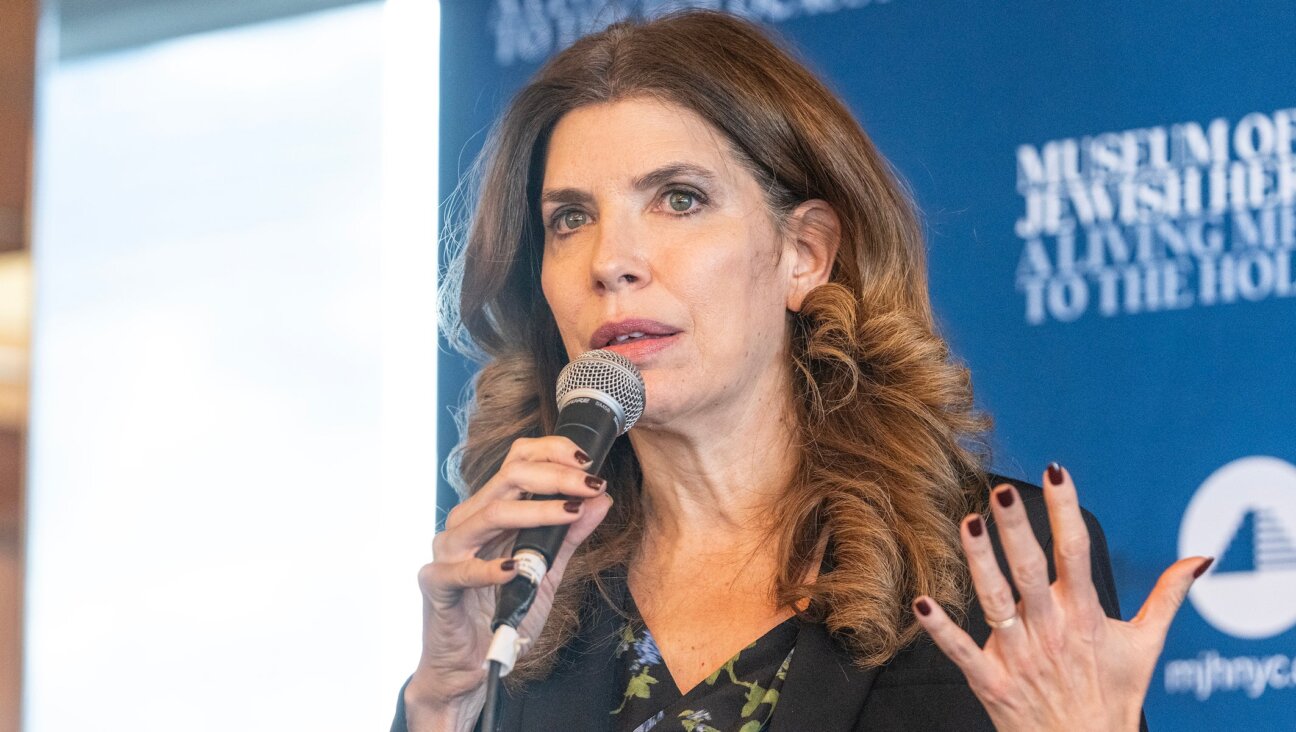Imagining Life of Dona Gracia, Portuguese Jew and Richest Woman in World

Graphic by Angelie Zaslavsky
(Haaretz) — About 10 years ago, while visiting the Museum of Jewish Art and History in Paris, Israeli journalist Naomi Keren noticed an ancient silver medallion that bore the likeness of Dona Gracia Nasi. “I was taken aback,” Keren says. “What I saw contradicted everything I knew about the use of art in connection with portraits in the Jewish world, because of the Second Commandment about making graven images or likenesses.” Two other aspects of the medallion also came as a surprise to Keren: it carried the image of a woman at its center, and the accompanying inscription was in Hebrew.
“I didn’t know Dona Gracia’s life story, but the medallion piqued my curiosity,” Keren recalls. So much so that she spent the next decade delving into the life of the 16th-century Jewish stateswoman and businesswoman, and writing a historical novel about her. In the course of her research, she discovered that portraits were in fact a feature of Jewish art during many periods in the past. Ironically, the portrait on the medallion Keren saw in the museum turned out to be not that of the famous Dona Gracia but of her niece, who had the same name.
“Current research is almost completely certain that the woman on the medallion is not her,” Keren states. “The piece was minted in Italy in 1558, the year of her niece’s marriage, and at a time when Dona Gracia had not been in Italy for five years. Furthermore, the woman in the medallion is young, but in 1558 Dona Gracia was no longer a young woman. According to most evaluations, it is not her.”
Keren’s novel, “La Senora” (in Hebrew), consists of imagined diary entries and letters written by Dona Gracia (1510-1569). The first of these fictional letters was ostensibly sent in 1537 from Lisbon, Dona Gracia’s birthplace. The others are “postmarked” Antwerp, Venice and other scenes of her tempestuous life.
Initially, Keren set out to write a historical study rather than a novel. Before becoming a journalist, she obtained a degree in general history and an M.A. from the Schechter Institute of Jewish Studies. She completed her study of Dona Gracia two years ago, but was unsatisfied with the result.
The manuscript was neither sufficiently academic nor sufficiently literary, she felt. Her first thought was to extend the historical research and turn it into a doctoral thesis. Ultimately, though, in consultation with the literary editor Haim Pesach, she decided to take the opposite track and write Dona Gracia’s life as a work of fiction.
“As we know,” Keren says, “the study of history is always carried out from the present into the past. To know how things happened exactly, researchers need to be on hand in the past, which is of course impossible. We can draw very close to the historical truth − if we assume that it exists − but only up to a certain point. There will always be gaps that need to be filled in.”
From that perspective, she notes, “I think I did the maximum. I tried to research as thoroughly as possible the period in which Dona Gracia lived: the utensils people used, what kind of lavatories they used (or didn’t use), what the fabrics they wore felt like on the body. I examined things that are perceived as extremely trivial, but wide gaps still remained. The research was unable to illuminate what she felt in any particular period of her life, for example; or what she thought about, or what bothered her.”
For many years, the medallion she saw in the museum was indeed thought to be a representation of Dona Gracia. But there is no visual documentation of her, says Keren. “There is no painting, definitely no picture. In fact, there is no direct testimony relating to her. There are no diaries, no letters, no text she herself wrote. There is no object that is associated directly with her. Her name appears only in external documents, written by the authorities in the countries in which she lived and was active.”
Hidden siblings
It was not just Dona Gracia’s eventful life that drew Keren. In retrospect, after that decade of research “and almost living in her company,” she realized that her attraction to the 16th-century woman was generated in part by her own personal biography. “Strong women and complex identities were elements in the milieu in which I grew up,” she says.
Her mother, Inger, was born in Denmark to an upper middle class Christian family. She studied social work in Edinburgh and did her internship in London under Anna Freud, the daughter of the founder of psychoanalysis. There she encountered Jewish orphans from World War II and decided to help.
In the mid-1950s, Keren relates, “Inger met with the Israeli ambassador to Denmark to ask how she could be of assistance. He suggested that she go to Israel and help treat elderly Holocaust survivors in Jerusalem. And that is just what she did. She went to Jerusalem and was employed as a psychiatric social worker. She met my father, Shlomo Borer, a writer and journalist, at a party, and they were married three months later.”
Her mother “never really fully belonged here,” Keren says. “She possessed a complex personality made up of several identities that sometimes seemed contradictory and sometimes could be peacefully integrated. Naturally, something of this passed to me as well. I think that writing about Dona Gracia helped me come to terms with that complexity − hers and mine − more easily.”
Keren, 50, was born in Tel Aviv and grew up in the city’s solidly middle class Old North section. “As an only child, I was always certain that I had a hidden brother or sister,” she recalls. “At one stage I was absolutely sure of it and I poked around in my parents’ things looking for information about them. “Alternatively, it also crossed my mind that I might be an adopted child. Later, I discovered that this is often the case with only children. I met a few others, and they had gone through the same stage.
“My mother died four years ago,” she continues, “and I took home many crates containing her effects. Some of them are still sealed. I am now slowly starting to open them. There is also a language barrier in connection with what she left behind, which is why I am now learning Danish. Regrettably, my mother thought that if I were to learn two languages as a child, I would connect less to the place I lived in and would not have a mother tongue, in the sense of ties and roots. So she spoke only Hebrew to me, and with my father also English. I only heard a great deal of Danish in the house when my grandparents from Denmark came to visit for a month every year when I was a girl.”
Keren did her military service as an announcer on Army Radio for three years. There she met Naftali, who was a civilian technician at the station, and married him when she was 20.
Following her service she enrolled in Tel Aviv University to study history, and had dreams of an academic career. But her background and experience at Army Radio led her to audition as a continuity announcer for Israel Television, which at the time operated the only channel in the country. “In the early 1980s they were thinking of returning to that format [an announcer between programs to tell viewers what was coming up next] and they held screen tests for the job. From the auditions they always took someone for a different job, such as to host a music program or join the sports unit. And every year I went home to get on with my life.
“Then, one year, after we got back from a summer trip to London, I found a message from the channel’s chief director that they were looking for me urgently. I went to Jerusalem and met with Yair Stern, who was head of the news department. He appointed me the announcer of two late-night newscasts and anchor of ‘Mabat’ [the prime-time nightly news] once a week.
“For six years I anchored ‘Mabat,’ was a night news editor, a reporter for ‘Mabat’ and all kinds of other things, and throughout I was a newscaster. I left because my third son was born two months premature. I was scheduled to read the news that night, but in the morning I went into labor.”
Friend of the sultan
Keren’s research for her novel went beyond Dona Gracia’s life story, encompassing the social, cultural and even geographical milieus in which her heroine was active. To get a feel for life in 16th-century Venice, she pored over ancient maps of the city. “It wasn’t until I looked at one of the maps in a collection at the Hebrew University of Jerusalem that I was able to understand certain aspects of the physical space in which Dona Gracia lived,” she says. “The site of the Jewish ghetto in Venice is extremely crowded now. You absolutely cannot see the spatial aspect. But on the old map you can see that it was actually a plaza that was surrounded by buildings, like the wall that encloses the island. In a split second, I suddenly imagined her standing in the center of that plaza, in the midst of that emptiness, in the winter, with snowflakes flying about.”
Dona Gracia was born in Portugal to a family of Marranos − Jews on the Iberian Peninsula who converted to Christianity, usually under coercion. At the age of 18, she married Francisco Mendes, who was from a wealthy merchant family of Portuguese Marranos. He died eight years later, leaving Dona Gracia half his fortune. Of the other half he gave a third to the poor and left the remainder to their daughter, Ana. Dona Gracia was appointed custodian of the girl and her assets.
Seven years later, in 1543, Dona Gracia became the recipient of another inheritance, when her brother-in-law, Diogo – who was married to her younger sister, Brianda – also died. He left his entire fortune to his daughter and appointed Dona Gracia her custodian. His widow received only her dowry money. The terms of the will sparked a complicated legal battle between the sisters, compounded by mutual informing to the Inquisition authorities. In the end, Dona Gracia obtained control of most of the family business and became one of the richest women in the world, if not the richest.
The Mendes brothers had controlled one of the largest economic empires in Europe. Their major source of profit lay in the importation of spices, particularly black pepper from the West Indies, on their fleet of ships. Banking and trading in precious stones were also lucrative for them. Dona Gracia managed the inheritance well. This could hardly be taken for granted in the case of a 16th-century woman with Jewish roots, which at times made her subject to life-threatening persecution.
According to Keren, “Dona Gracia did more than manage the far-flung business affairs of the late brothers. She continued to control the company, led it intelligently and increased its assets. Naturally, she also continued to be the head of the whole family, despite the internecine dispute. She had her nephew, Joao Micas [Joseph Nasi, c. 1524-1579], marry her daughter and groomed him to be her right-hand man in managing the business. In the final stages of her life, she handed him the reins completely. He achieved a very important place in the Ottoman court in his own right as well, and became the sultan’s factotum. It is now thought that the title character in Shakespeare’s ‘The Merchant of Venice’ is based on him.”
Dona Gracia gained esteem for more than her business skills. Politically, too, Keren depicts her as a strong, assertive woman. An example of her toughness can be seen in the boycott of Jewish merchants she led against the Italian port city of Ancona.
Located on Italy’s east coast, Ancona was a key commercial site of the Mediterranean basin. The city’s prosperity was attributed in part to the activity of a number of businessmen among the Portuguese Marranos, who were invited to Ancona in the 1540s. However, in 1555, at the order of Pope Paul IV, and contrary to the assurances of his predecessor, Marcellus II, a few of them were arrested by the Inquisition authorities and their property confiscated.
Some of the detainees managed to escape, but others were sold into slavery after expressing remorse and sentenced to be forced rowers on oar-powered ships. Twenty-four of them were burned alive at the stake. Keren maintains that the reason for their persecution had to do with internal issues of Christendom, notably the intensifying struggle between Catholicism and Protestantism.
Dona Gracia was in Istanbul at this time, but among those arrested in Ancona was an agent of hers, and she apparently knew a few of the others personally. She interceded on their behalf at the sultan’s court. At her recommendation, the sultan sent a letter to the pope requesting the release of several of the detainees, to whom he wished to grant his protection. When nothing came of this effort, Dona Gracia organized a number of Jewish communities and groups of Marranos in the Ottoman Empire to boycott the port in Ancona. The boycott lasted eight months, though historians are divided about its effectiveness. According to Keren, the act was important mainly for its “consciousness-changing” character.
Keren argues that Dona Gracia “transmitted to European Christendom the message that actions of this kind would not pass in silence, and that mutual surety exists between the different Jewish communities.” Furthermore, she says, Dona Gracia herself underwent a change of consciousness. A case in point is her leasing of the city of Tiberias from the Turkish sultan four years later.
“In the absence of documents, it is difficult to know what Dona Gracia’s intention was in leasing the city,” Keren says. “However, we can assume that it was the result of a thought process that had matured in her, in the wake of the events. Nowadays, there is an anachronistic tendency to see this as a ‘Zionist’ act, born of a desire to establish a state or havens for persecuted Jews. Personally, I think we have to be extremely careful about these concepts, as the nation-state and the Zionist movement were created on a foundation of 19th-century concepts. I don’t think people in the 16th century were capable of thinking in those terms.
“Factually, we know − and this is verified in the documents − that the Nasi family leased Tiberias from the Ottoman sultan in the 1560s. Internal correspondence between the sultan’s court in Istanbul and the Ottoman governor of Damascus mentions a woman named Gracia, who approached the sultan about this. She was ready to pay leasing fees and she presented the idea as an economic project that would increase tax collection in the region. The lease lasted 10 years, but was not extended after Dona Gracia’s death. I don’t think we can know what exactly she tried to achieve. This is one of those chapters that history has left open. But there is no doubt that we see here buds of Jewish leadership, which wants to take control and take public responsibility.”
Free widow
Keren developed an ambivalent attitude toward her heroine in the course of researching and writing the book. “On the one hand, it is clear that people in positions of power like this become manipulative and crafty,” she says. “At the same time, it is impossible not to esteem her and her activity. She leaves Lisbon as a young widow with little apparent knowledge of business, and within a few years becomes the manager of a worldwide economic empire.
“I also give her quite a bit of credit for remaining a widow and not remarrying,” adds Keren. “I think we can say with a great deal of certainty that this was a matter of choice; and also that her motivation was a desire to be independent. The point is that as a woman in the 16th century, you were always someone’s property. First your father’s, then your husband’s, and if he died you became your son’s property. In that period, only widows could remain independent women, move about freely, become merchants and develop what we now call a career. In certain senses, widows were accorded a special status in the social hierarchy in compensation for their loneliness. I think, too, that this was her way of remaining an independent woman.”
Keren adds that her work on the book “did not change me in terms of acquiring new feminist insights. Still, I think it was the closing of a circle with myself in terms of identities, which is a subject that continues to speak to me. I understood that it is all right to be both one thing and another. For example, in my private case − or in what I transmit to the family, and to my children − the fact that we have a Christian heritage and that this is nothing to be ashamed of, even if we live in a country of Jews.
“In a philosophy course I took at the Schechter Institute, I had a very hard time coping with texts from ‘The Kuzari’ [by 12th-century Spanish Jewish philosopher Yehuda Halevi]. There were passages there which, as the daughter of a convert, were extremely difficult for me to read, even to realize that such outlooks exist. The book talks about some divine spark which exists only in those who are born to Jews, and that those who join the Jewish people will never be able to be true Jews. I found that very hard to live with.”
That same complex identity − in Keren’s case, as a Jewish woman with Christian roots − was Dona Gracia’s fate, too. “As a daughter of Portuguese Marranos, she was born and educated a Catholic,” Keren explains. “She probably did not hear about her Jewish roots until she was an adolescent. The custom in many Marrano families was to reveal the secret around the age of the bar or bat mitzvah. We don’t know when she found out, though it was probably before her marriage. Her husband, in contrast, was born a Jew and was baptized as a boy. In her case it was simpler.”
In Christian countries, Dona Gracia had to present herself as a Christian woman, Keren notes, “even though everyone, including the authorities, knew she was really a Jew. The thing was to catch her out and place her in the hands of the Inquisition. The Inquisition, after all, was not aimed against Jews but against Christians who were not observing Christianity ‘properly.’ Technically, from the moment she was baptized and became a Christian, there was no way back. Because, if they found out she had taken that route, she would be condemned to death and all her property would be confiscated. The truth is that she had nowhere to go back to, because she had never been a Jew. The only place she could live publicly as a Jew was in the Ottoman Empire, under Muslim rule, because they didn’t really care one way or the other.
“As a Jew, she established a beit midrash [an institution of Jewish religious study] in Istanbul − again in her own inimitable way. She installed a rabbi as its head and underwrote the living expenses of the students for one year only. Afterward, they had to leave and yield their place to someone else who wanted to hear the word of the living God from the rabbi.”
Dona Gracia’s heritage is greater and more significant than the sum of her deeds, Keren believes. “I think there was a certain message that I wanted to convey through her character,” she observes, “a message about tolerance, and to show the existence of a great many shades within Judaism. That is where I think my connection with Dona Gracia was very powerful: In regard to identities, and the fact that different identities can coexist in harmony, one alongside the other, in the same person.”
Haaretz Magazine writer Aviva Lori conducted the interview with Naomi Keren shortly before her death. Shay Fogelman helped complete the article.
For more stories, go to Haaretz.com or to subscribe to Haaretz, click here and use the following promotional code for Forward readers: FWD13.
















